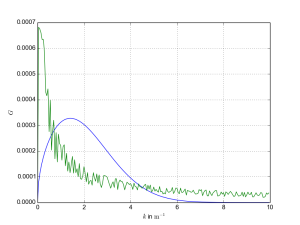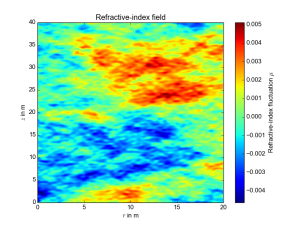When listening to an aircraft flying over, you can hear that the level and spectral contents fluctuate somewhat. These fluctuations are due to turbulence in the atmosphere, affecting the sound generation (variable load on engines) and the sound propagation. In order to create a plausible auralisation of aircraft noise these fluctuations have to be accounted for.
Turbulent flow can be modeled as a superposition of a spectrum of fluctuations and eddies upon a mean flow. A common approach for noise predictions methods to include the effects of atmospheric turbulence is to use a statistical approach; generate many random 'frozen' turbulence fields, calculate for each of these how sound propagates through them and then average your results. The 'frozen' fields represent snapshots in time of how the atmosphere could look like. These snapshots are calculated based on a spectrum of fluctuations. Well known descriptions of these spectra are the Gaussian and von Karman spectra.
The figure belows shows a portion of two turbulence spectra.
A random turbulence field is created by the superposition of modes. The figure below shows the amplitude of these modes as function of wavenumber.
And finally a figure showing the refractive-index fluctuation. The field is generated using a Von Karman spectrum and 200 modes.


